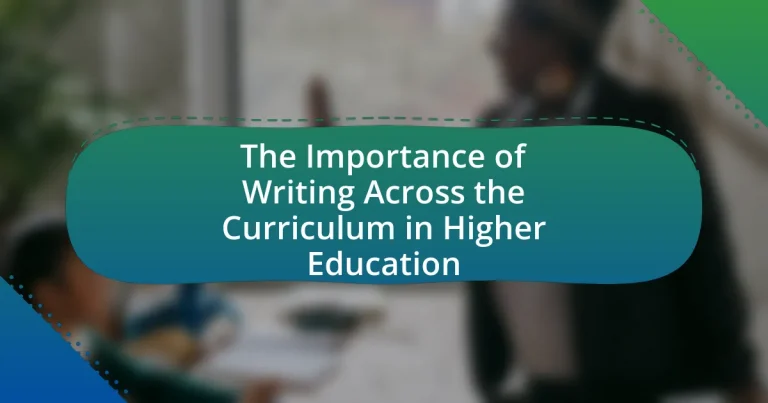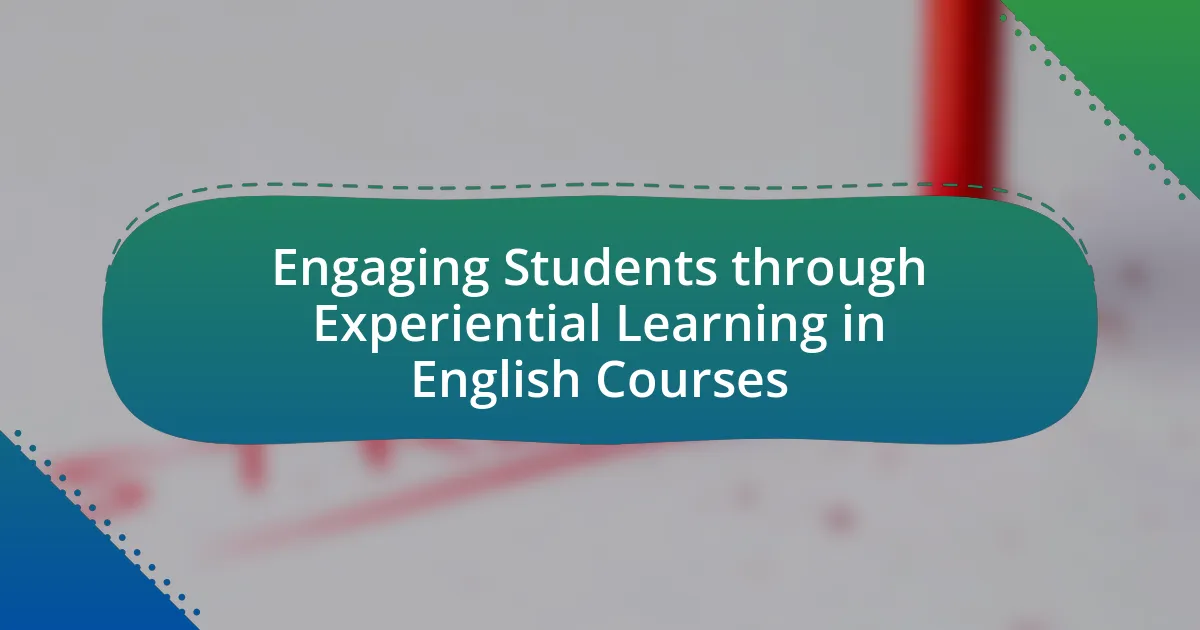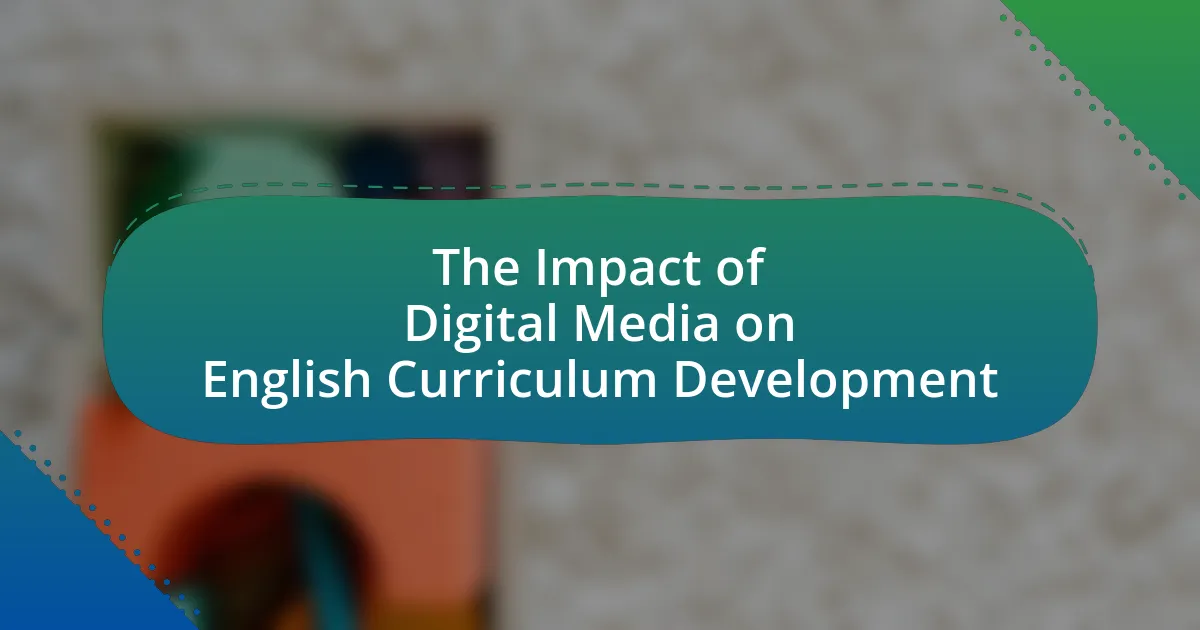Writing Across the Curriculum (WAC) is a vital pedagogical approach in higher education that integrates writing instruction across various disciplines to enhance students’ critical thinking, communication skills, and understanding of subject matter. Research shows that students who engage in writing activities across different subjects exhibit improved academic performance, retention of knowledge, and deeper cognitive processing. The article explores the significance of writing as a fundamental skill, the benefits of WAC for student engagement and retention, the challenges educators face in its implementation, and effective strategies for integrating writing into diverse curricula. Additionally, it highlights the role of faculty development and resources in supporting writing initiatives, ultimately emphasizing the importance of writing for academic success and professional readiness.

What is the Importance of Writing Across the Curriculum in Higher Education?
Writing Across the Curriculum (WAC) is crucial in higher education as it enhances students’ critical thinking, communication skills, and disciplinary knowledge. By integrating writing into various subjects, students learn to express complex ideas clearly and effectively, which is essential for academic success and professional readiness. Research indicates that students who engage in writing across different disciplines demonstrate improved retention of content and a deeper understanding of the material. For instance, a study by the National Writing Project found that writing in diverse contexts fosters greater engagement and mastery of subject matter, ultimately leading to higher academic performance.
Why is writing considered a fundamental skill in higher education?
Writing is considered a fundamental skill in higher education because it is essential for effective communication and critical thinking. In academic settings, students must articulate their ideas clearly and persuasively through written assignments, which fosters deeper understanding of the subject matter. Research indicates that writing enhances cognitive processes; for instance, a study published in the journal “Educational Psychology” by Graham and Perin (2007) found that writing instruction significantly improves students’ overall academic performance. Thus, writing not only serves as a medium for expressing knowledge but also as a tool for learning and intellectual development in higher education.
How does writing enhance critical thinking and learning?
Writing enhances critical thinking and learning by requiring individuals to organize their thoughts, analyze information, and articulate arguments clearly. This process fosters deeper understanding and retention of knowledge, as evidenced by research conducted by the National Council of Teachers of English, which found that students who engage in writing across the curriculum demonstrate improved analytical skills and higher academic performance. Writing encourages reflection and evaluation of ideas, leading to more nuanced perspectives and better problem-solving abilities.
What role does writing play in student engagement and retention?
Writing significantly enhances student engagement and retention by fostering critical thinking and active participation in learning. Engaging in writing activities encourages students to articulate their thoughts, analyze information, and connect concepts, which deepens their understanding of the material. Research indicates that courses incorporating writing assignments see higher retention rates; for instance, a study by the National Survey of Student Engagement found that students who frequently engage in writing report greater satisfaction with their educational experience. This correlation suggests that writing not only aids in comprehension but also promotes a sense of belonging and investment in their academic journey.
How does writing across the curriculum differ from traditional writing instruction?
Writing across the curriculum emphasizes integrating writing instruction into all subject areas, while traditional writing instruction typically focuses on teaching writing skills in isolation, often within English or language arts classes. This approach fosters critical thinking and communication skills across disciplines, as students practice writing in various contexts, enhancing their ability to articulate ideas relevant to specific fields. Research indicates that students who engage in writing across the curriculum demonstrate improved writing proficiency and deeper understanding of content, as evidenced by studies showing that interdisciplinary writing assignments lead to higher levels of student engagement and retention of knowledge.
What are the key principles of writing across the curriculum?
The key principles of writing across the curriculum include integration, collaboration, and purposefulness. Integration emphasizes embedding writing assignments in all subjects to enhance learning, as research shows that writing improves comprehension and retention of material. Collaboration involves faculty working together to develop writing assignments that align with course objectives, fostering a cohesive educational experience. Purposefulness ensures that writing tasks are relevant and meaningful, motivating students to engage with the content. These principles are supported by studies indicating that writing enhances critical thinking and communication skills, essential for academic success and professional readiness.
How can writing be integrated into various disciplines?
Writing can be integrated into various disciplines by incorporating writing assignments and activities that align with the specific goals and content of each field. For instance, in science courses, students can write lab reports to articulate their findings, while in history classes, they can compose analytical essays to explore historical events. Research indicates that writing enhances critical thinking and comprehension across disciplines, as shown in a study by the National Writing Project, which found that students who engage in writing across the curriculum demonstrate improved academic performance. This integration not only reinforces subject matter understanding but also develops essential communication skills that are vital in any professional context.
What challenges do educators face in implementing writing across the curriculum?
Educators face several challenges in implementing writing across the curriculum, including a lack of training, insufficient time, and varying levels of student writing proficiency. Many educators report feeling unprepared to teach writing effectively due to limited professional development opportunities focused on writing instruction. Additionally, the demands of the curriculum often leave little time for writing activities, which can hinder integration into various subjects. Furthermore, students come to the classroom with diverse writing skills, making it difficult for educators to address individual needs and ensure that all students can engage meaningfully with writing tasks. These challenges collectively impede the successful implementation of writing across the curriculum in higher education settings.
How can faculty be supported in adopting writing across the curriculum?
Faculty can be supported in adopting writing across the curriculum through targeted professional development programs that emphasize writing pedagogy. These programs can include workshops, peer mentoring, and access to resources that demonstrate effective writing instruction strategies. Research indicates that faculty who participate in such professional development are more likely to integrate writing into their courses, as evidenced by a study from the National Writing Project, which found that 85% of participating teachers reported increased confidence in teaching writing after training. Additionally, providing faculty with access to writing centers and collaborative spaces can enhance their ability to implement writing assignments effectively, fostering a culture of writing within the institution.
What are common misconceptions about writing instruction in higher education?
Common misconceptions about writing instruction in higher education include the belief that writing is solely the responsibility of English departments and that it is only necessary for humanities courses. Many educators assume that students should already possess adequate writing skills upon entering college, neglecting the need for ongoing writing development across all disciplines. Additionally, there is a misconception that writing instruction is limited to formal essays, overlooking the importance of diverse writing forms such as reports, presentations, and digital communication. Research indicates that integrating writing across the curriculum enhances student learning and retention, as evidenced by studies showing improved critical thinking and communication skills when writing is emphasized in various subjects.

What are the benefits of writing across the curriculum for students?
Writing across the curriculum benefits students by enhancing their critical thinking, communication skills, and subject comprehension. Engaging in writing activities in various disciplines allows students to articulate their understanding, analyze information, and synthesize ideas effectively. Research indicates that students who write regularly in different subjects demonstrate improved academic performance and retention of knowledge, as evidenced by a study published in the Journal of Educational Psychology, which found that writing enhances learning by promoting deeper cognitive processing. Additionally, writing across the curriculum fosters collaboration and peer feedback, further enriching the learning experience and preparing students for real-world communication demands.
How does writing improve students’ academic performance?
Writing improves students’ academic performance by enhancing critical thinking, comprehension, and retention of information. Engaging in writing activities requires students to organize their thoughts, articulate arguments, and analyze content, which deepens their understanding of the subject matter. Research conducted by the National Writing Project indicates that students who write regularly perform better in assessments, as writing fosters a deeper engagement with the material. Additionally, a study published in the Journal of Educational Psychology found that students who participated in writing-to-learn activities showed significant improvements in their overall academic achievement, demonstrating the direct correlation between writing and enhanced academic performance.
What evidence supports the correlation between writing and academic success?
Research indicates a strong correlation between writing proficiency and academic success. Studies show that students who engage in regular writing activities tend to achieve higher grades and demonstrate better critical thinking skills. For instance, a study published in the “Journal of Educational Psychology” by Graham and Perin (2007) found that writing instruction significantly improved students’ performance across various subjects, highlighting that effective writing skills enhance comprehension and retention of material. Additionally, a report from the National Writing Project emphasizes that writing across the curriculum fosters deeper learning and engagement, further supporting the link between writing and academic achievement.
How does writing contribute to the development of professional skills?
Writing enhances the development of professional skills by improving critical thinking, communication, and analytical abilities. Engaging in writing tasks requires individuals to organize their thoughts, articulate ideas clearly, and present arguments logically, which are essential skills in any professional setting. Research indicates that students who participate in writing-intensive courses demonstrate higher levels of cognitive engagement and problem-solving skills, as evidenced by a study published in the Journal of Educational Psychology, which found that writing activities significantly improve students’ ability to analyze and synthesize information. Thus, writing serves as a foundational tool for cultivating essential professional competencies.
In what ways does writing across the curriculum prepare students for the workforce?
Writing across the curriculum prepares students for the workforce by enhancing their communication skills, critical thinking, and adaptability. Effective communication is essential in nearly all professions, and writing across various subjects helps students practice articulating ideas clearly and persuasively. Research indicates that employers prioritize strong writing skills; a survey by the National Association of Colleges and Employers found that 73% of employers seek candidates with the ability to communicate effectively in writing. Additionally, engaging in writing tasks across disciplines fosters critical thinking, as students learn to analyze information and construct coherent arguments. This versatility in writing also cultivates adaptability, enabling students to tailor their communication style to different audiences and contexts, a crucial skill in diverse work environments.
What specific writing skills are valued by employers?
Employers value specific writing skills such as clarity, conciseness, and the ability to tailor content to different audiences. Clarity ensures that the message is easily understood, while conciseness helps in communicating ideas effectively without unnecessary elaboration. The ability to adapt writing style and tone to suit various audiences is crucial for effective communication in diverse workplace settings. According to a survey by the National Association of Colleges and Employers, 73% of employers seek candidates with strong written communication skills, highlighting the importance of these abilities in the job market.
How does writing foster collaboration and communication skills?
Writing fosters collaboration and communication skills by requiring individuals to articulate their thoughts clearly and engage with others’ perspectives. When students write collaboratively, they must negotiate ideas, provide constructive feedback, and synthesize diverse viewpoints, which enhances their ability to communicate effectively. Research indicates that writing assignments that involve peer review or group projects lead to improved interpersonal skills and a deeper understanding of content, as students learn to express their ideas while considering the input of their peers. This process not only strengthens their writing abilities but also cultivates essential skills for teamwork and effective communication in professional environments.

How can institutions effectively implement writing across the curriculum?
Institutions can effectively implement writing across the curriculum by integrating writing assignments into all courses and providing faculty training on writing pedagogy. This approach ensures that students practice writing in various contexts, reinforcing their skills and enhancing their learning. Research indicates that when writing is incorporated into diverse subjects, such as science and humanities, students demonstrate improved critical thinking and retention of material. For example, a study by the National Writing Project found that students who engage in writing across disciplines perform better academically, highlighting the effectiveness of this strategy in fostering comprehensive educational development.
What strategies can be employed to promote writing across different disciplines?
To promote writing across different disciplines, educators can implement interdisciplinary writing assignments that encourage collaboration among departments. This approach fosters a shared understanding of writing conventions specific to each field, enhancing students’ ability to adapt their writing style accordingly. Research indicates that integrating writing into various subjects improves critical thinking and retention of material, as demonstrated in a study by the National Writing Project, which found that students who engage in writing across the curriculum show higher academic performance. Additionally, providing professional development for faculty on effective writing instruction techniques can further support this initiative, ensuring that all educators are equipped to emphasize writing in their courses.
How can curriculum design facilitate writing integration?
Curriculum design can facilitate writing integration by embedding writing assignments across various disciplines, ensuring that students practice and develop their writing skills in context. This approach not only reinforces the importance of writing as a critical skill but also allows students to engage with course content more deeply. Research indicates that when writing is integrated into the curriculum, such as through collaborative projects or reflective essays, students demonstrate improved writing proficiency and critical thinking skills. For instance, a study by the National Council of Teachers of English found that writing across the curriculum leads to higher student engagement and better retention of material, highlighting the effectiveness of this pedagogical strategy.
What role do assessment and feedback play in writing across the curriculum?
Assessment and feedback are crucial in writing across the curriculum as they enhance student learning and improve writing skills. Effective assessment provides students with clear expectations and benchmarks for their writing, while timely feedback helps them understand their strengths and areas for improvement. Research indicates that formative assessment, which occurs during the learning process, significantly boosts student engagement and writing proficiency. For instance, a study by Sadler (1989) in “Formative Assessment and the Design of Instructional Systems” highlights that feedback is most effective when it is specific, actionable, and linked to learning objectives. This integration of assessment and feedback fosters a supportive learning environment, encouraging students to refine their writing across various disciplines.
What resources are available to support writing across the curriculum initiatives?
Writing across the curriculum initiatives can be supported by various resources, including professional development workshops, writing centers, and online platforms. Professional development workshops provide educators with strategies to integrate writing into their teaching practices, enhancing student engagement and learning outcomes. Writing centers offer tailored support for students, helping them improve their writing skills across different disciplines. Online platforms, such as Purdue OWL and the Writing Across the Curriculum Clearinghouse, provide accessible materials and guidelines for both instructors and students, promoting effective writing practices in diverse academic contexts. These resources collectively contribute to the successful implementation of writing across the curriculum initiatives in higher education.
How can faculty development programs enhance writing instruction?
Faculty development programs can enhance writing instruction by equipping educators with effective pedagogical strategies and resources tailored to improve student writing skills. These programs often include workshops, peer collaborations, and access to research-based practices that focus on integrating writing across various disciplines. For instance, a study by the National Writing Project found that teachers who participated in professional development focused on writing instruction reported increased confidence and improved student writing outcomes. By fostering a community of practice among faculty, these programs create an environment where educators can share successful writing assignments and assessment techniques, ultimately leading to a more cohesive approach to writing instruction across the curriculum.
What tools and technologies can assist in writing instruction?
Tools and technologies that assist in writing instruction include word processing software, online grammar checkers, collaborative writing platforms, and educational apps. Word processing software like Microsoft Word and Google Docs provides essential features such as spell check, formatting options, and the ability to track changes, which enhance the writing process. Online grammar checkers, such as Grammarly and ProWritingAid, offer real-time feedback on grammar, style, and clarity, helping students improve their writing skills. Collaborative writing platforms like Google Docs and Microsoft OneNote facilitate peer review and group projects, allowing multiple users to edit and comment simultaneously. Educational apps like Hemingway and Scrivener support writers in organizing their thoughts and improving readability. These tools collectively enhance the writing instruction process by providing immediate feedback, fostering collaboration, and improving overall writing quality.
What best practices should educators follow for successful writing across the curriculum?
Educators should implement integrated writing assignments, provide clear guidelines, and offer regular feedback to ensure successful writing across the curriculum. Integrated writing assignments encourage students to apply writing skills in various subjects, enhancing their understanding and retention of content. Clear guidelines help students understand expectations and improve their writing quality. Regular feedback allows educators to address individual student needs and promote continuous improvement. Research indicates that writing across the curriculum enhances critical thinking and communication skills, which are essential for academic success and professional readiness.
How can educators create a supportive writing environment for students?
Educators can create a supportive writing environment for students by fostering a culture of collaboration and providing constructive feedback. Collaborative activities, such as peer review sessions, encourage students to share ideas and learn from each other, enhancing their writing skills. Constructive feedback, delivered in a timely and specific manner, helps students understand their strengths and areas for improvement, which is essential for their development as writers. Research indicates that environments where students feel safe to express their thoughts and receive guidance lead to higher engagement and better writing outcomes. For instance, a study by the National Writing Project found that students who participated in supportive writing communities showed significant improvement in their writing abilities.
What are effective methods for incorporating peer review in writing assignments?
Effective methods for incorporating peer review in writing assignments include structured guidelines, peer review workshops, and the use of rubrics. Structured guidelines provide clear expectations for students, ensuring they understand the criteria for evaluating their peers’ work. Peer review workshops facilitate collaborative learning environments where students can discuss feedback in real-time, enhancing their critical thinking and communication skills. The use of rubrics standardizes the assessment process, allowing students to focus on specific aspects of writing, such as organization, clarity, and argumentation. Research indicates that peer review not only improves writing quality but also fosters a sense of community among students, as highlighted in the study “Peer Review in Higher Education: A Review of the Literature” by Topping (1998), which emphasizes the positive impact of peer feedback on student engagement and learning outcomes.




